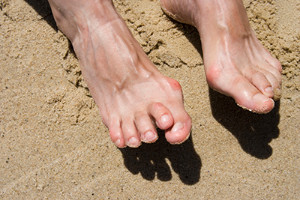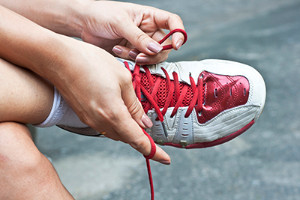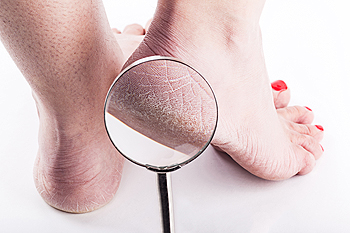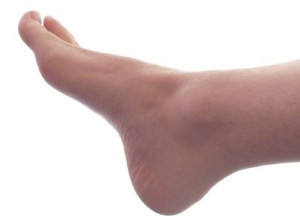
Drexel Hill (484) 521-0233
West Chester (610) 436-5883

Drexel Hill (484) 521-0233
West Chester (610) 436-5883

 Hammertoe is a type of foot deformity that occurs when the toe begins to bend or buckle, and it is sometimes caused when the feet constantly rub against footwear, like high heels. Consequently, this condition is more commonly found in women compared to men. Laurie Keegan, a sufferer of hammertoe, has this to say about the condition: “I can't do the things I want to do. I get on the treadmill and I can only be on there for about 20 minutes. It's just too painful. I can't continue.” Fortunately, surgery can be done to repair hammertoe, but you should consult with your podiatrist before you begin to seek it as an option.
Hammertoe is a type of foot deformity that occurs when the toe begins to bend or buckle, and it is sometimes caused when the feet constantly rub against footwear, like high heels. Consequently, this condition is more commonly found in women compared to men. Laurie Keegan, a sufferer of hammertoe, has this to say about the condition: “I can't do the things I want to do. I get on the treadmill and I can only be on there for about 20 minutes. It's just too painful. I can't continue.” Fortunately, surgery can be done to repair hammertoe, but you should consult with your podiatrist before you begin to seek it as an option.
Hammertoe
Hammertoes can be a painful condition to live with. For more information, contact the podiatrists from Dr. Siegerman & Associates. Our doctors will answer any of your foot- and ankle-related questions.
Hammertoe is a foot deformity that affects the joints of the second, third, fourth, or fifth toes of your feet. It is a painful foot condition in which these toes curl and arch up, which can often lead to pain when wearing footwear.
Symptoms
Causes
Genetics – People who are genetically predisposed to hammertoe are often more susceptible
Arthritis – Because arthritis affects the joints in your toes, further deformities stemming from arthritis can occur
Trauma – Direct trauma to the toes could potentially lead to hammertoe
Ill-fitting shoes – Undue pressure on the front of the toes from ill-fitting shoes can potentially lead to the development of hammertoe
Treatment
Orthotics – Custom made inserts can be used to help relieve pressure placed on the toes and therefore relieve some of the pain associated with it
Medications – Oral medications such as anti-inflammatories or NSAIDs could be used to treat the pain and inflammation hammertoes causes. Injections of corticosteroids are also sometimes used
Surgery – In more severe cases where the hammertoes have become more rigid, foot surgery is a potential option
If you have any questions please contact one of our offices located in Drexel Hill and West Chester, PA . We offer the newest diagnostic and treatment technologies for all your foot and ankle needs.
 Although you may be excited to try on your brand new pair of shoes, you should be careful to avoid getting blisters while wearing them. Blisters are not only uncomfortable, but they often force you to walk in an unnatural way to compensate for the pain they cause. Fortunately, there are some tips you can follow to avoid getting blisters and having to deal with them while wearing your new kicks. One tip is to walk around in your new shoes at home prior to wearing them out in public. Wearing your shoes at home will help loosen them up so that the shoes are already broken-in when you are ready for regular use. Another tip is to make sure that you are wearing proper socks. While most people tend to wear ankle socks, they offer very little protection for your feet compared to longer ones. You should also make sure that the socks you wear are made up of a material that dries quickly. A material like cotton, which tends to stay damp for a while, may soften the skin and make you more susceptible to blisters.
Although you may be excited to try on your brand new pair of shoes, you should be careful to avoid getting blisters while wearing them. Blisters are not only uncomfortable, but they often force you to walk in an unnatural way to compensate for the pain they cause. Fortunately, there are some tips you can follow to avoid getting blisters and having to deal with them while wearing your new kicks. One tip is to walk around in your new shoes at home prior to wearing them out in public. Wearing your shoes at home will help loosen them up so that the shoes are already broken-in when you are ready for regular use. Another tip is to make sure that you are wearing proper socks. While most people tend to wear ankle socks, they offer very little protection for your feet compared to longer ones. You should also make sure that the socks you wear are made up of a material that dries quickly. A material like cotton, which tends to stay damp for a while, may soften the skin and make you more susceptible to blisters.
Blisters are prone to making everyday activities extremely uncomfortable. If your feet are hurting, contact the podiatrists of Dr. Siegerman & Associates. Our doctors can provide the care you need to keep you pain-free and on your feet.
Foot Blisters
Foot blisters develop as a result of constantly wearing tight or ill-fitting footwear. This happens due to the constant rubbing from the shoe, which can often lead to pain.
What Are Foot Blisters?
A foot blister is a small fluid-filled pocket that forms on the upper-most layer of the skin. Blisters are filled with clear fluid and can lead to blood drainage or pus if the area becomes infected.
How Do Blisters Form?
Blisters on the feet are often the result of constant friction of skin and material, usually by shoe rubbing. Walking in sandals, boots, or shoes that don’t fit properly for long periods of time can result in a blister. Having consistent foot moisture and humidity can easily lead to blister formation.
Prevention & Treatment
It is important to properly care for the affected area in order to prevent infection and ease the pain. Do not lance the blister and use a Band-Aid to provide pain relief. Also, be sure to keep your feet dry and wear proper fitting shoes. If you see blood or pus in a blister, seek assistance from a podiatrist.
If you have any questions, please feel free to contact one of our offices located in Drexel Hill and West Chester, PA . We offer the newest diagnostic and treatment technologies for all your foot care needs.
 The first step to getting into a proper running routine is to make sure you are wearing the right running shoes. The proper shoe will help to correct biomechanical issues and prevent injury. You should always go to a sneaker store that specializes in running shoes so that the workers can help you find a sneaker that fits your foot strike. There are three main types of runners based on foot strikes: overpronators (when the foot rolls inward too much), neutral pronators (feet roll inward slightly), and supinators (feet don’t roll inward enough). Certain running shoe stores will have you run on a treadmill so that the workers can best determine which shoe type will fit you properly. You will know the shoe is a good fit if you “feel like you want to go run immediately," said runner Dimity McDowell.
The first step to getting into a proper running routine is to make sure you are wearing the right running shoes. The proper shoe will help to correct biomechanical issues and prevent injury. You should always go to a sneaker store that specializes in running shoes so that the workers can help you find a sneaker that fits your foot strike. There are three main types of runners based on foot strikes: overpronators (when the foot rolls inward too much), neutral pronators (feet roll inward slightly), and supinators (feet don’t roll inward enough). Certain running shoe stores will have you run on a treadmill so that the workers can best determine which shoe type will fit you properly. You will know the shoe is a good fit if you “feel like you want to go run immediately," said runner Dimity McDowell.
If you are a runner, wearing the right running shoe is essential. For more information, contact the podiatrists from Dr. Siegerman & Associates. Our doctors can provide the care you need to keep you pain-free and on your feet.
Choosing the Right Running Shoe for Your Foot Type
To increase performance and avoid the risk of injury, it is important to choose the right running shoe based on your foot type. The general design of running shoes revolves around pronation, which is how the ankle rolls from outside to inside when the foot strikes the ground.
If you have any questions please feel free to contact one of our offices located in Drexel Hill and West Chester, PA . We offer the newest diagnostic and treatment technologies for all your foot and ankle needs.
The plantaris muscle originates above the knee and inserts into the heel joining the Achilles tendon. While the plantaris muscle has no vital function, it is adjacent to the gastrocnemius and soleus muscles which connect with the Achilles tendon for support. If the Achilles tendon begins to tear, this can have serious implications on the leg which will no longer be able to push the foot off the ground. If this injury occurs to you, it is important that you seek help from a podiatrist as soon as possible.
plantaris muscle originates above the knee and inserts into the heel joining the Achilles tendon. While the plantaris muscle has no vital function, it is adjacent to the gastrocnemius and soleus muscles which connect with the Achilles tendon for support. If the Achilles tendon begins to tear, this can have serious implications on the leg which will no longer be able to push the foot off the ground. If this injury occurs to you, it is important that you seek help from a podiatrist as soon as possible.
Achilles tendon injuries need immediate attention to avoid future complications. If you have any concerns, contact the podiatrists of Dr. Siegerman & Associates. Our doctors can provide the care you need to keep you pain-free and on your feet.
What Is the Achilles Tendon?
The Achilles tendon is a tendon that connects the lower leg muscles and calf to the heel of the foot. It is the strongest tendon in the human body and is essential for making movement possible. Because this tendon is such an integral part of the body, any injuries to it can create immense difficulties and should immediately be presented to a doctor.
What Are the Symptoms of an Achilles Tendon Injury?
There are various types of injuries that can affect the Achilles tendon. The two most common injuries are Achilles tendinitis and ruptures of the tendon.
Achilles Tendinitis Symptoms
Rupture Symptoms
Treatment and Prevention
Achilles tendon injuries are diagnosed by a thorough physical evaluation, which can include an MRI. Treatment involves rest, physical therapy, and in some cases, surgery. However, various preventative measures can be taken to avoid these injuries, such as:
If you have any questions please feel free to contact one of our offices located in Drexel Hill and West Chester, PA . We offer the newest diagnostic tools and technology to treat your foot and ankle needs.
 With warmer weather in our midst, many may be thinking about summer sandals and in turn, exposing their feet. Some people, however, may be wary of revealing their bare feet due to concerns about cracked heels and dry skin. If you are one of these people, consider the following tip to have your feet sandal-ready. Slather petroleum jelly onto the feet before bedtime and then put on a pair of socks. This will ensure that the jelly is fully absorbed and kept against the skin, helping to draw water to the surface and make for smooth feet in the morning. Excess petroleum jelly can be rinsed off with warm soap and water.
With warmer weather in our midst, many may be thinking about summer sandals and in turn, exposing their feet. Some people, however, may be wary of revealing their bare feet due to concerns about cracked heels and dry skin. If you are one of these people, consider the following tip to have your feet sandal-ready. Slather petroleum jelly onto the feet before bedtime and then put on a pair of socks. This will ensure that the jelly is fully absorbed and kept against the skin, helping to draw water to the surface and make for smooth feet in the morning. Excess petroleum jelly can be rinsed off with warm soap and water.
Cracked heels are unsightly and can cause further damage to your shoes and feet. If you have any concerns, contact the podiatrists from Dr. Siegerman & Associates. Our doctors can provide the care you need to keep you pain-free and on your feet.
Cracked Heels
Cracked heels appear unappealing and can make it harder for you walk around in sandals. Aside from looking unpleasant, cracked heels can also tear stockings, socks, and wear out your shoes. There are several methods to help restore a cracked heel and prevent further damage.
How Do You Get Them?
Dry skin is the number one culprit in creating cracked heels. Many athletes, walkers, joggers, and even swimmers suffer from cracked heels. Age and skin oil production play a role to getting cracked heels as well.
Promote Healing
Over the counter medicines can help, especially for those that need instant relief or who suffer from chronic dry feet.
Wear Socks – Wearing socks with medicated creams helps lock in moisture.
Moisturizers – Applying both day and night will help alleviate dryness which causes cracking.
Pumice Stones – These exfoliate and remove dead skin, which allows for smoother moisturizer application and better absorption into the skin.
Change in Diet
Eating healthy with a well-balanced diet will give the skin a fresh and radiant look. Your body responds to the kinds of food you ingest. Omega-3 fatty acids and zinc supplements can also revitalize skin tissue.
Most importantly, seek professional help if unsure how to proceed in treating cracked heels. A podiatrist will help you with any questions or information needed.
If you have any questions, please feel free to contact one of our offices located in Drexel Hill and West Chester, PA . We offer the newest diagnostic and treatment technologies for all your foot care needs.
 During the winter season at the beginning of the year, many people strive to get into shape for the upcoming summer season. Before jumping straight into working out however, many podiatrists agree that it is important to warm up and stretch properly. Injuries such as stress fractures, tendonitis, and plantar fasciitis are all more likely to occur if the feet are not stretched properly. In addition to stretching and warming up, wearing supportive sneakers and slowly increasing high impact activities can also minimize your risk of suffering these injuries.
During the winter season at the beginning of the year, many people strive to get into shape for the upcoming summer season. Before jumping straight into working out however, many podiatrists agree that it is important to warm up and stretch properly. Injuries such as stress fractures, tendonitis, and plantar fasciitis are all more likely to occur if the feet are not stretched properly. In addition to stretching and warming up, wearing supportive sneakers and slowly increasing high impact activities can also minimize your risk of suffering these injuries.
Stretching the feet is a great way to prevent injuries. If you have any concerns with your feet consult with the podiatrists from Dr. Siegerman & Associates. Our doctors will assess your condition and provide you with quality foot and ankle treatment.
Stretching the Feet
Being the backbone of the body, the feet carry your entire weight and can easily become overexerted, causing cramps and pain. As with any body part, stretching your feet can serve many benefits. From increasing flexibility to even providing some pain relief, be sure to give your feet a stretch from time to time. This is especially important for athletes or anyone performing aerobic exercises, but anyone experiencing foot pain or is on their feet constantly should also engage in this practice.
Great ways to stretch your feet:
Individuals who tend to their feet by regular stretching every day should be able to minimize foot pain and prevent new problems from arising.
If you have any questions, please feel free to contact one of our offices located in Drexel Hill and West Chester, PA . We offer the newest diagnostic and treatment technologies for all your foot care needs.
 Pregnancy can create additional pressure on the feet, making certain everyday activities and responsibilities difficult for women. Women who work desk jobs should ensure that they’re sitting in chairs that offer optimal support, while women who spend a majority of their time standing should occasionally elevate their feet using a foot rest. Wearing comfortable shoes is also a must and should never be overlooked. Elevating the feet can also help pregnant women in managing edema, as the feet often swell during pregnancy.
Pregnancy can create additional pressure on the feet, making certain everyday activities and responsibilities difficult for women. Women who work desk jobs should ensure that they’re sitting in chairs that offer optimal support, while women who spend a majority of their time standing should occasionally elevate their feet using a foot rest. Wearing comfortable shoes is also a must and should never be overlooked. Elevating the feet can also help pregnant women in managing edema, as the feet often swell during pregnancy.
Pregnant women with swollen feet can be treated with a variety of different methods that are readily available. For more information about other cures for swollen feet during pregnancy, consult with the podiatrists from Dr. Siegerman & Associates. Our doctors will attend to all of your foot and ankle needs.
What Foot Problems Can Arise During Pregnancy?
One problem that can occur is overpronation, which occurs when the arch of the foot flattens and tends to roll inward. This can cause pain and discomfort in your heels while you’re walking or even just standing up, trying to support your baby.
Another problem is edema, or swelling in the extremities. This often affects the feet during pregnancy but tends to occur in the later stages.
How Can I Keep My Feet Healthy During Pregnancy?
If you have any questions please feel free to contact one of our offices located in Drexel Hill and West Chester, PA . We offer the newest diagnostic and treatment technologies for all your foot and ankle needs.
 Those who enjoy hiking as a regular activity should be sure to employ foot care while on the trail to avoid potential pain and injury. The first step to maintaining proper foot care while hiking is to be aware of one’s surroundings. Many hiking-related foot injuries and conditions often occur as a result of not being aware while on the trail: rolled ankles, broken toes, and blisters. When hiking, be sure to wear shoes that are breathable and that either dry quickly or are waterproof. When trying on hiking boots or shoes, finding a great fit is important. With modern innovations in footwear, hiking boots are becoming lighter and more comfortable.
Those who enjoy hiking as a regular activity should be sure to employ foot care while on the trail to avoid potential pain and injury. The first step to maintaining proper foot care while hiking is to be aware of one’s surroundings. Many hiking-related foot injuries and conditions often occur as a result of not being aware while on the trail: rolled ankles, broken toes, and blisters. When hiking, be sure to wear shoes that are breathable and that either dry quickly or are waterproof. When trying on hiking boots or shoes, finding a great fit is important. With modern innovations in footwear, hiking boots are becoming lighter and more comfortable.
Everyday foot care is very important to prevent infection and other foot ailments. If you need your feet checked, contact the podiatrists from Dr. Siegerman & Associates. Our doctors can provide the care you need to keep you pain-free and on your feet.
Everyday Foot Care
Often, people take care of their bodies, face and hair more so than they do for their feet. But the feet are a very important aspect of our bodies, and one that we should pay more attention to. Without our feet, we would not be able to perform most daily tasks.
It is best to check your feet regularly to make sure there are no new bruises or cuts that you may not have noticed before. For dry feet, moisturizer can easily be a remedy and can be applied as often as necessary to the affected areas. Wearing shoes that fit well can also help you maintain good foot health, as well as making it easier to walk and do daily activities without the stress or pain of ill-fitting shoes, high heels, or even flip flops. Wearing clean socks with closed shoes is important to ensure that sweat and bacteria do not accumulate within the shoe. Clean socks help to prevent Athlete’s foot, fungi problems, bad odors, and can absorb sweat.
If you have any questions please feel free to contact one of our offices located in Drexel Hill and West Chester, PA . We offer the newest diagnostic and treatment technologies for all your foot and ankle needs.
 If you have hammertoes, it may be due to a number of factors including improperly-fitting shoes or muscle and nerve diseases that can affect your feet. Hammertoes are described as bent and curled toes, seeming to resemble the claw of a hammer. The condition is permanent and may require treatment if pain progresses. Typical treatment includes wearing the proper footwear and physical therapy. A final option is surgery for severe cases, but consulting with your podiatrist first about your condition is recommended before deciding on the surgical option.
If you have hammertoes, it may be due to a number of factors including improperly-fitting shoes or muscle and nerve diseases that can affect your feet. Hammertoes are described as bent and curled toes, seeming to resemble the claw of a hammer. The condition is permanent and may require treatment if pain progresses. Typical treatment includes wearing the proper footwear and physical therapy. A final option is surgery for severe cases, but consulting with your podiatrist first about your condition is recommended before deciding on the surgical option.
Hammertoe
Hammertoes can be a painful condition to live with. For more information, contact the podiatrists from Dr. Siegerman & Associates. Our doctors will answer any of your foot- and ankle-related questions.
Hammertoe is a foot deformity that affects the joints of the second, third, fourth, or fifth toes of your feet. It is a painful foot condition in which these toes curl and arch up, which can often lead to pain when wearing footwear.
Symptoms
Causes
Genetics – People who are genetically predisposed to hammertoe are often more susceptible
Arthritis – Because arthritis affects the joints in your toes, further deformities stemming from arthritis can occur
Trauma – Direct trauma to the toes could potentially lead to hammertoe
Ill-fitting shoes – Undue pressure on the front of the toes from ill-fitting shoes can potentially lead to the development of hammertoe
Treatment
Orthotics – Custom made inserts can be used to help relieve pressure placed on the toes and therefore relieve some of the pain associated with it
Medications – Oral medications such as anti-inflammatories or NSAIDs could be used to treat the pain and inflammation hammertoes causes. Injections of corticosteroids are also sometimes used
Surgery – In more severe cases where the hammertoes have become more rigid, foot surgery is a potential option
If you have any questions please contact one of our offices located in Drexel Hill and West Chester, PA . We offer the newest diagnostic and treatment technologies for all your foot and ankle needs.
 There are over 100 different varieties of HPV, or human papilloma virus. Nearly 12% of the global population have had warts at one time, and plantar warts are but one of these types. They all share one basic characteristic, they have the ability to infect skin cells. Many people, when they hear the term HPV, think that it refers to genital warts. But this is not the case, and HPV can manifest itself in many different forms. Plantar warts occur on the feet, typically on the palms or the soles. They can be flat or raised, and usually occur in dry, cracked areas of the foot. Treatments vary in scope and effectiveness. If you think you may have a plantar wart, talk to your podiatrist and go through the treatment options available.
There are over 100 different varieties of HPV, or human papilloma virus. Nearly 12% of the global population have had warts at one time, and plantar warts are but one of these types. They all share one basic characteristic, they have the ability to infect skin cells. Many people, when they hear the term HPV, think that it refers to genital warts. But this is not the case, and HPV can manifest itself in many different forms. Plantar warts occur on the feet, typically on the palms or the soles. They can be flat or raised, and usually occur in dry, cracked areas of the foot. Treatments vary in scope and effectiveness. If you think you may have a plantar wart, talk to your podiatrist and go through the treatment options available.
Plantar warts can be very uncomfortable. If you need your feet checked, contact the podiatrists from Dr. Siegerman & Associates. Our doctors will assist you with all of your foot and ankle needs.
About Plantar Warts
Plantar warts are the result of HPV, or human papillomavirus, getting into open wounds on the feet. They are mostly found on the heels or balls of the feet.
While plantar warts are generally harmless, those experiencing excessive pain or those suffering from diabetes or a compromised immune system require immediate medical care. Plantar warts are easily diagnosed, usually through scraping off a bit of rough skin or by getting a biopsy.
Symptoms
Treatment
To help prevent developing plantar warts, avoid walking barefoot over abrasive surfaces that can cause cuts or wounds for HPV to get into. Avoiding direct contact with other warts, as well as not picking or rubbing existing warts, can help prevent the further spread of plantar warts. However, if you think you have developed plantar warts, speak to your podiatrist. He or she can diagnose the warts on your feet and recommend the appropriate treatment options.
If you have any questions please feel free to contact one of our offices located in Drexel Hill and West Chester, PA . We offer the newest diagnostic and treatment technologies for all your foot and ankle needs.
Request a free copy of
Laser Away Foot Pain!
today.
